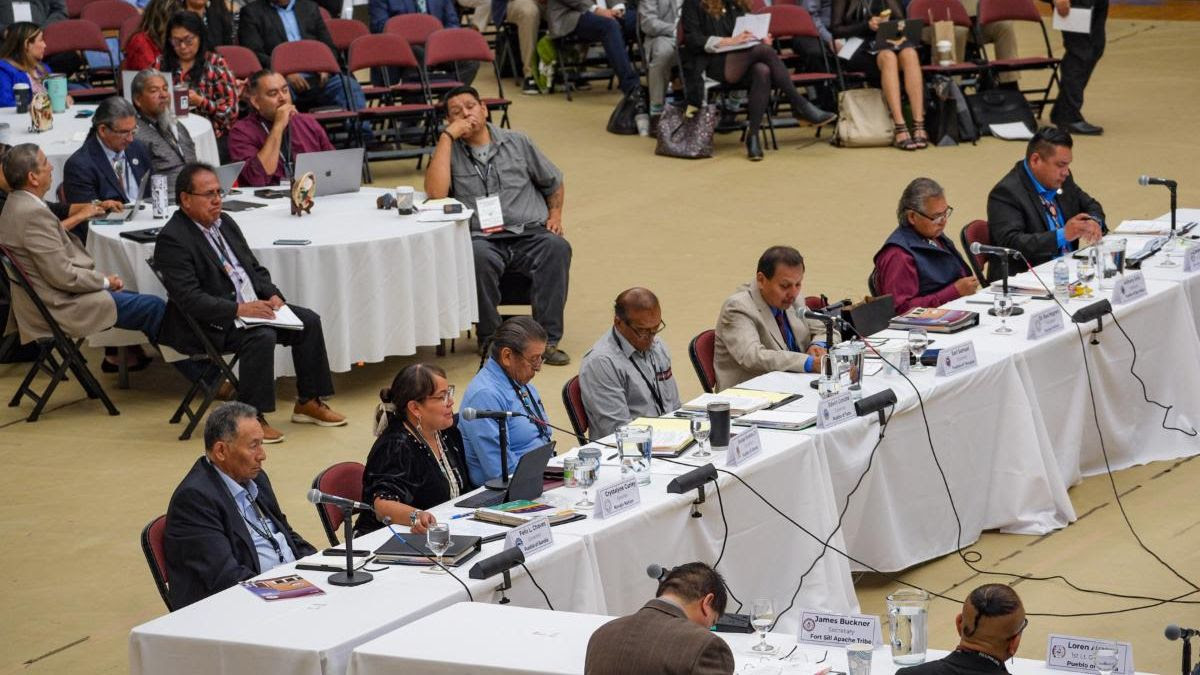
- Details
- By Native News Online Staff
At the 2025 New Mexico Tribal Leaders Summit, held at the Santa Fe Indian School on Tuesday, Navajo Nation Speaker Crystalyne Curley issued a powerful call to action, urging tribal nations and the State of New Mexico to work together to identify and document the impacts of recent federal funding cuts on tribal communities.
The summit focused on pressing issues such as federal policy changes affecting tribal programs, economic development in Indian Country, and state mechanisms like New Mexico Capital Outlay and the Tribal Infrastructure Fund.
Speaker Curley stressed the importance of gathering comprehensive data on federal cuts to programs like Indian Health Service (IHS), Supplemental Nutrition Assistance Program (SNAP), and tribal higher education services. This information, she said, is critical for effective coordination and advocacy.
“We are looking at a modern-day monster,” Curley warned, emphasizing the need for a united front among tribal leaders and a stronger partnership with the state to defend core services administered through the Bureau of Indian Affairs (BIA) and Bureau of Indian Education (BIE).
New Mexico Governor Michelle Lujan Grisham joined tribal leaders at the summit to directly address mounting concerns over federal budget reductions and their ripple effects on state-administered funding for tribes. She reiterated her administration’s support for tribal sovereignty and a shared commitment to advocacy.
“We share a fierce dedication to our communities. We are one state—one collective group—working to improve quality of life,” the governor said.
She outlined shared priorities, including economic development, environmental resilience, health care access, education, and public safety. Governor Lujan Grisham also contrasted New Mexico’s inclusive tribal-state partnerships with federal approaches that often sideline tribal voices.
“The federal government is moving away from sovereignty, while New Mexico leans into it,” she said. “There’s nothing more important than our mutual respect and shared resolve to do better for New Mexico and all its people.”
The governor also cautioned about the far-reaching consequences of shifting federal policy, noting potential losses in Medicaid funding, cuts to special education, and reductions to food assistance programs like SNAP—amounting to billions of dollars in the coming years.
Speaker Curley underscored the need for ongoing monitoring of federal actions. “To keep up with the executive orders being issued, the Navajo Nation Council holds weekly leadership meetings,” she said. “It’s time for all tribes to start mapping which projects are being impacted—and by how much.”
Calling for unity and shared strength in the face of growing uncertainty, Curley added: “This is a battle—a fight every day. But if we don’t fall to the tactics of divide and conquer, we will be stronger together.”
Governor Lujan Grisham closed the summit by reaffirming her administration’s unwavering commitment to defending tribal interests and strengthening government-to-government relationships during this critical time.
More Stories Like This
Native News Weekly (August 25, 2024): D.C. BriefsUS Presidents in Their Own Words Concerning American Indians
Two West Virginia Guardsmen Shot Near White House
Next on Native Bidaské: Chef Sean Sherman Talks “Turtle Island” and the Future of Indigenous Food
Deer Camp: A Family Tradition That Runs Deep
Help us tell the stories that could save Native languages and food traditions
At a critical moment for Indian Country, Native News Online is embarking on our most ambitious reporting project yet: "Cultivating Culture," a three-year investigation into two forces shaping Native community survival—food sovereignty and language revitalization.
The devastating impact of COVID-19 accelerated the loss of Native elders and with them, irreplaceable cultural knowledge. Yet across tribal communities, innovative leaders are fighting back, reclaiming traditional food systems and breathing new life into Native languages. These aren't just cultural preservation efforts—they're powerful pathways to community health, healing, and resilience.
Our dedicated reporting team will spend three years documenting these stories through on-the-ground reporting in 18 tribal communities, producing over 200 in-depth stories, 18 podcast episodes, and multimedia content that amplifies Indigenous voices. We'll show policymakers, funders, and allies how cultural restoration directly impacts physical and mental wellness while celebrating successful models of sovereignty and self-determination.
This isn't corporate media parachuting into Indian Country for a quick story. This is sustained, relationship-based journalism by Native reporters who understand these communities. It's "Warrior Journalism"—fearless reporting that serves the 5.5 million readers who depend on us for news that mainstream media often ignores.
We need your help right now. While we've secured partial funding, we're still $450,000 short of our three-year budget. Our immediate goal is $25,000 this month to keep this critical work moving forward—funding reporter salaries, travel to remote communities, photography, and the deep reporting these stories deserve.
Every dollar directly supports Indigenous journalists telling Indigenous stories. Whether it's $5 or $50, your contribution ensures these vital narratives of resilience, innovation, and hope don't disappear into silence.
 The stakes couldn't be higher. Native languages are being lost at an alarming rate. Food insecurity plagues many tribal communities. But solutions are emerging, and these stories need to be told.
The stakes couldn't be higher. Native languages are being lost at an alarming rate. Food insecurity plagues many tribal communities. But solutions are emerging, and these stories need to be told.
Support independent Native journalism. Fund the stories that matter.
Levi Rickert (Potawatomi), Editor & Publisher

